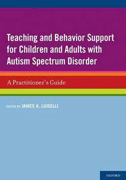
Teaching and behavior support for children and adults with autism spectrum disorder: a practitioner's guide
Luiselli, James K.
This guide is an indispensible asset, appropriate for any behavioral specialist, on all aspects of this increasingly prevalent disorder.Teaching and Behavior Support for Children and Adults with Autism Spectrum Disorder brings together contributed chapters on assessment, instruction, and behavioral intervention procedures unique to the autism population. The number of children diagnosed with autism has increased dramatically in the last decade, and a growing number of behavior analysts, psychologists, educators, and speech pathologists-toname a few-are just starting to regularly treat individuals with autism. Children and adults with autism spectrum disorder (ASD) require specialized instruction and behavior support to teach them critical skills and establish a meaningful quality of life. However, these objectives can only beachieved if professional and paraprofessional service providers have access to the most effective evidence-based and empirically supported methods for teaching children with autism. Similarly, practitioners must know about effective intervention methods that can be implemented to reduce and eliminateproblem behaviors frequently displayed by people who have ASD.This guide is an indispensible asset, appropriate for any behavioral specialist, on all aspects of this increasingly prevalent disorder. Teaching and Behavior Support for Children and Adults with Autism Spectrum Disorder brings together contributed chapters on assessment, instruction, and behavioral intervention procedures unique to the autism population. Each chapter covers a single topic according to a uniform format, which will ease comprehension and facilitate procedural adaptationin "real world" settings such as school, home, and the community. Usable advice and methods for teaching difficult skills, such as self-care, verbal language, and communication, are provided. Authored by recognized experts, the concise and readable chapters also feature forms, illustrations, summary tables,and resource lists to further guide practitioners in selecting "best practice" methods. Taking into account specific settings, different age groups, and practitioner experience, this book will serve as a resource for educators, psychologists, and behavior specialists in the field of autism education and treatment, and as an educational tool for those enrolled in university classes training to become practitioners. INDICE: List of Contributors I How to Conduct Assessment 1. Behavioral Observation and Measurement by Jonathan Tarbox, Adel C. Najdowski, and Taira M. Lanagan 2. Functional Behavioral Assessment (FBA) by Derek D. Reed and Richard L. Azulay 3. Functional Analysis (FA) by Gregory P. Hanley 4. Stimulus Preference Assessment by Jeffrey H. Tiger and Megan L. Kliebert 5. Intervention Integrity Assessment by Florence D. DiGennaro Reed and Robin S. Codding 6. Skills Assessment by Hanna C. Rue 7. Outcome Assessment by Susan M. Wilczynski II How to Teach Skills 8. Toilet Training by Jennifer Gillis, Kimberly Smith and SaraWhite 9. Feeding by Jennifer D. Bass and Kimberly A. Kroeger 10. Self-Care byMichelle D. Wallace and Mitch J. Fryling 11. Augmentative and Alternative Communication by Ralf W. Schlosser and Jeff Sigafoos 12. Verbal Language and Communication by Jeff Sigafoos, Ralf W. Schlosser, Mark F. O'Reilly, and Giulio E.Lancioni 13. Interactive Social Skills by Mark O'Reilly, Amanda
- ISBN: 978-0-19-973640-9
- Editorial: Oxford University
- Encuadernacion: Rústica
- Páginas: 240
- Fecha Publicación: 26/05/2011
- Nº Volúmenes: 1
- Idioma: Inglés
